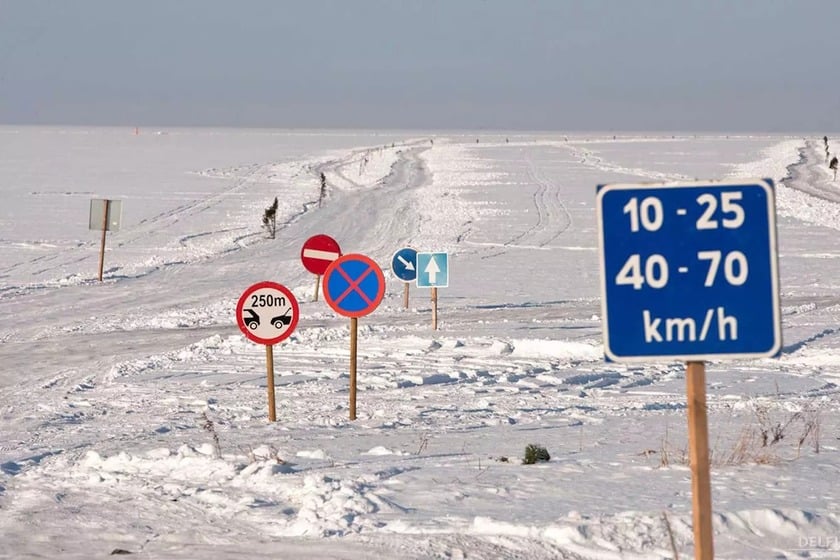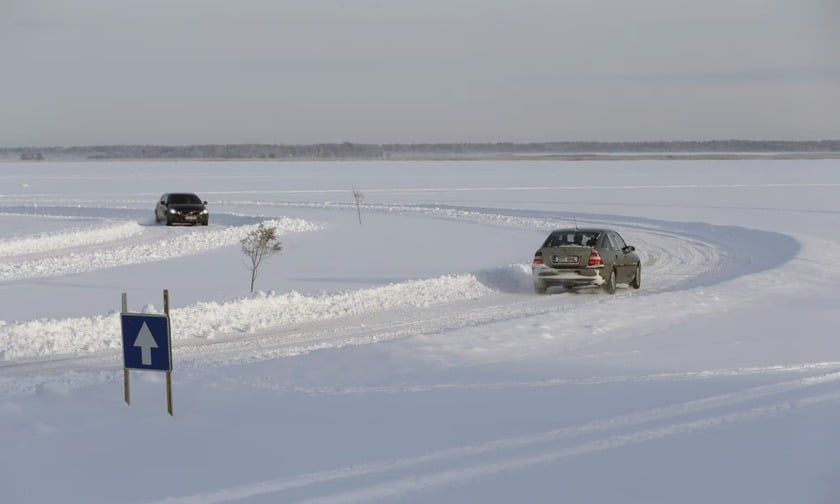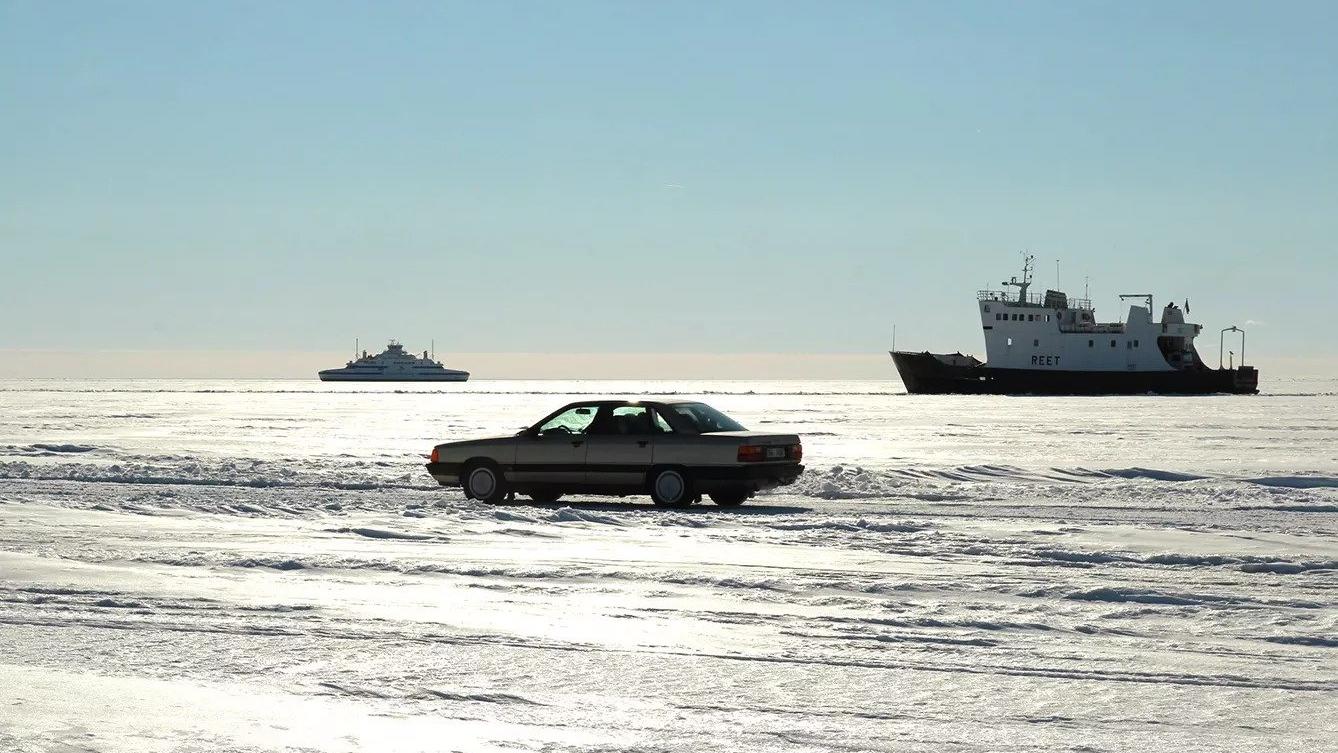Driving on icy roads
Estonia has seven official ice roads – roads that only appear in winter when the weather is cold enough for the Baltic Sea to freeze at least 22 cm thick. The most notable is the 26 km Rohuküla-Hiiumaa route, which is said to be the longest ice road in Europe. Another 15 km route connects Triigi on the island of Saaremaa with Tärkma, south of Hiiumaa. These are temporary roads, lasting for a few weeks to a few months each year, usually from January to mid-March.

Ice road in Estonia
On these roads, people do not set the maximum speed limit as usual, but instead prohibit driving at... average speed. Specifically, you are only allowed to drive under 25 km/h or over 40 km/h, but absolutely cannot maintain it within 25-40 km/h. It sounds absurd, but the reality is very convincing: the movement of the vehicle in this speed range can create resonance waves on the ice surface, similar to the wave of the bow of a ship when moving on water. If it continues long enough, this wave can cause the surface to crack, leading to unpredictable consequences.

You are only allowed to drive below 25 km/h or above 40 km/h, but absolutely cannot maintain it within 25-40 km/h.
The “reverse” rules
In addition to the speed limit, there are other unusual rules. Drivers are required to remove their seat belts and leave their doors unlocked while driving on icy roads. This may seem counterintuitive, but it makes it easier to get out in the event of a break in the ice. This is a rare but not impossible occurrence.
Vehicle spacing must also be maintained at least 250 meters to avoid placing loads on a particular ice area. Vehicles are not allowed to stop in the middle of the road, and when a road closure signal is issued, usually due to fog, ice cracks or rising temperatures, all vehicles must immediately turn around and notify the vehicles behind.
The ice is only open during the day and is inspected every morning by local teams. The quality of the ice is determined by its thickness, color, texture, and even the sound it makes when tapped on the surface. Small wooden planks are placed across small cracks to help vehicles pass through. The path is often marked with birch branches planted along the sides, acting as makeshift signs in the snow and ice landscape.

The distance between vehicles must also be maintained at least 250 meters to avoid concentrating the load on a particular ice area.
One of the most "safe" runways in the world
Interestingly, the Baltic Sea freezes more easily than many other seas, because the water is shallow, less salty, and has a constant flow of fresh water. Thanks to these unique conditions, Estonia is one of the few countries in the world that can maintain a full-fledged ice runway system year after year.
Estonia is not the only place with airstrips, but few have them as organized and safe as they are here. In Canada, some remote communities in the Northwest Territories or Nunavut also rely on airstrips to supply food and supplies during the winter. In Russia, especially in Siberia, “zimniks” – winter roads – stretch hundreds of kilometers across rivers and taiga, and are vital for indigenous people. But many of them are poorly marked, not regularly inspected, and pose greater risks than Estonia’s system.
However, risks are always present. One year, accidents occurred on unofficial routes, where people drove without permission from the authorities. Therefore, only roads certified by the Estonian Transport Authority are considered safe.

Estonia is not the only place with runways, but few places have such a well-organized and safe system as here.
Thin ice, thick joy
While seemingly a challenge for extreme racers, Estonia’s ice roads are a part of everyday life – a practical alternative to ferries, especially for people on islands like Hiiumaa and Saaremaa. Traveling by ice road is faster, cheaper and more flexible than the fixed schedules of ships.
Before the age of cars, Estonians traveled across these ice surfaces in horse-drawn carts. Today, with rally racing deeply rooted in local culture, the winter ice is also a playground for speed-loving drivers. Companies like icedriving.ee offer ice driving courses, including BMW mechanics and a 300km-a-day journey between Viljandi and Tartu, led by professional drivers like Sten Pentus.
It’s hard to imagine what it would be like to drive on the sea – not over a bridge, but actually on ice, with the ocean below. In ideal conditions, the sunlight reflecting off the snow makes the whole scene look like a fairy tale. In the distance, a few ships can be seen slowly gliding across the horizon, creating a feeling of both excitement and peace in the frozen nature.

In the distance, a few ships can be seen slowly gliding across the horizon, evoking a feeling of both excitement and peace amidst the icy nature.
Driving on ice in Estonia is a strange mix of adventure and discipline. You need a good car, a keen eye, nerves of steel, and a strict adherence to seemingly counterintuitive safety rules. But the reward is an experience like no other – a journey across the ocean without a boat, just a steady hand and a passion for discovery.




































